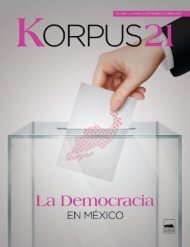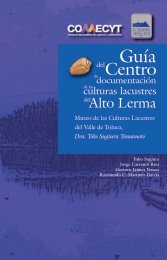Create successful ePaper yourself
Turn your PDF publications into a flip-book with our unique Google optimized e-Paper software.
MARY KAY VAUGHAN, EDUCATING THE SENSES: PEPE ZÚÑIGA AND MEXICO CITY’S REBEL GENERATION<br />
the need for hard work, for manual labor in a<br />
society whose higher classes deplored it, for<br />
savings and prevision, for study, discipline and<br />
responsibility. But he sang about these with humor,<br />
joy, and rhyme absent from school textbooks.<br />
He bid children to play, laugh, and imagine.<br />
Pepe taught them to me and explained his<br />
preferences on the long trips we took to Oaxaca.<br />
I came to see that Cri Cri’s repertoire required<br />
an analysis that involved both Pepe’s comments<br />
and my own textual reading assisted by academic<br />
analysis and other contemporaries’ memories.<br />
3 Most helpful to me was the literary analysis<br />
of Eve Kosofsky Sedgwick and Adam Frank.<br />
As they examined images of children in British<br />
literature in the transition from the nineteenth to<br />
the twentieth century, they argued that Charles<br />
Dickens’ abandoned child morphed into Christopher<br />
Robin, the playful, loved boy cared for by<br />
his nanny and his mother (Kosofsky and Frank,<br />
2003: 42-43).<br />
In Mexican popular culture, in a country where<br />
children were just beginning to read and gain<br />
access to radio, Cri-Cri was Christopher Robin.<br />
It is not that the indigent child disappeared from<br />
the Mexican streets or mass media, but rather<br />
that the loved child, who, like Christopher Robin,<br />
delighted in nature and his animal friends, came<br />
to occupy a central instructive position: a sort of<br />
discursive mandate, a rush of affect, the declaration<br />
of rights and love.<br />
“By awakening our imagination and our<br />
senses, Cri-Cri taught us conduct”, Pepe noted.<br />
In verse and music, Cri-Cri created images and<br />
sounds that prompted all the senses: to breathe<br />
in the aroma of the soup the elves made with<br />
daisies, carnations, and hibiscus, to watch the<br />
stream of water expand and contract in the rain<br />
and the sun, to turn sad over the old doll thrown<br />
into a dingy corner—she reminded Pepe of his<br />
own ragdoll Tunca. “The sounds of the train, the<br />
motors, the whistles, the chug chug chug. This<br />
song recalled for me all the things I had seen<br />
from the train when we came to Mexico City—<br />
the cows, the sheep, the bull, the cactus, the<br />
mountains—and the emotion I felt when the train<br />
passed through the tunnel and for a moment the<br />
world turned black!”.<br />
3 Cri Cri´s songs are of course published and most usefully<br />
for me in Cri-Cri: Canciones completas (Gabilondo, 1999).<br />
This version contains helpful reflections by artists and writers<br />
about their own childhood experiences of listening to Cri-Cri.<br />
I knew and shared with Pepe earlier school<br />
texts that treated nature as dangerous and<br />
threatening. We talked of how Cri-Cri turned nature<br />
into magic, beauty, and the promise of life.<br />
He sang of the butterfly as she flew out of a rose,<br />
flitting her wings turned silver in the sun. As they<br />
watched her, all the animals of the forest took up<br />
their musical instruments in a symphony of joy.<br />
Cri-Cri sang of the changing seasons, water that<br />
let the daisies blossom, the flowers that filled the<br />
meadow with a riot of colors, the breeze from<br />
the mountains that shaped the sugar cane into<br />
golden flutes, the moon which lit the forest and<br />
made the lake sparkle, signaling to the elves to<br />
break into dance, the crickets to sing, and the<br />
lambs to drink. It was a world to adore and not<br />
to destroy, to value nature was to value life and<br />
self and beauty.<br />
Perhaps above all, Pepe believed that Cri-Cri<br />
valued freedom. He lamented the fate of the<br />
Cuckoo bird condemned to emerge mechanically<br />
from the clock at a given hour, incapable<br />
of chirping when she wished. He celebrated the<br />
shoes which, defying the shoemaker, jumped out<br />
of their boxes and danced like crazy. But he condemned<br />
imprudence. When the cat Micifú sets<br />
out to sea in a shoe in search of treasure, he runs<br />
into a storm and discovers a bottle with a message:<br />
“Señor,” says the note, “Don’t be a fool.<br />
There is no greater treasure than studying.” So<br />
Micifú turned around. He went to school, studied<br />
hard and became a great doctor. “Cri-Cri stirred<br />
our imaginations with his world of animals, nature,<br />
and the personalities of our neighborhood,<br />
but he also criticized bad habits”, remembered<br />
Pepe. This promise that study, discipline and<br />
commitment would bring success was oft-repeated<br />
in the movies Pepe saw. How to negotiate<br />
the desire for freedom with the need for<br />
self-discipline and productive learning: this was<br />
a common challenge.<br />
Our exploration of cinema as a shared experience<br />
for children was somewhat different from<br />
our reading of Cri-Cri. Of course, Pepe described<br />
children flocking to the matinees, in groups or<br />
alone. They created a critical public, cheering,<br />
booing, clapping, stamping their feet and yelling<br />
at each other to shut up so they could concentrate<br />
on the films. The children’s films were<br />
products primarily of Mexican and Hollywood<br />
classical cinema. These had not been analyzed<br />
118



![bicentenario_1[V2]](https://img.yumpu.com/68677971/1/167x260/bicentenario-1v2.jpg?quality=85)
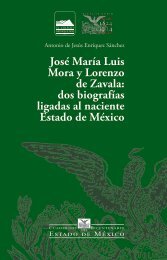
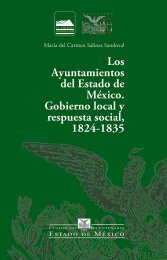

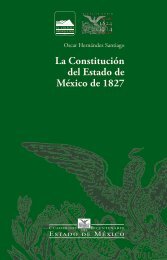
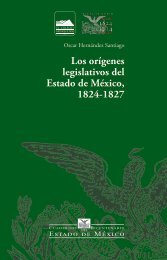
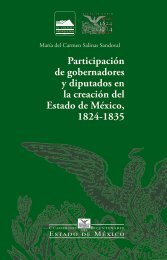
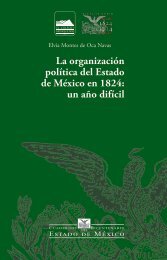
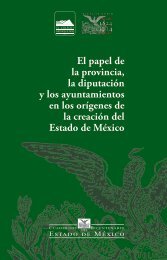
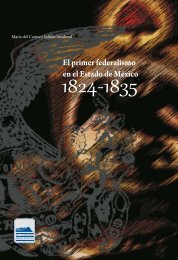
![El_primer_federalismoEM[final]_compressed (2)](https://img.yumpu.com/68483279/1/178x260/el-primer-federalismoemfinal-compressed-2.jpg?quality=85)
